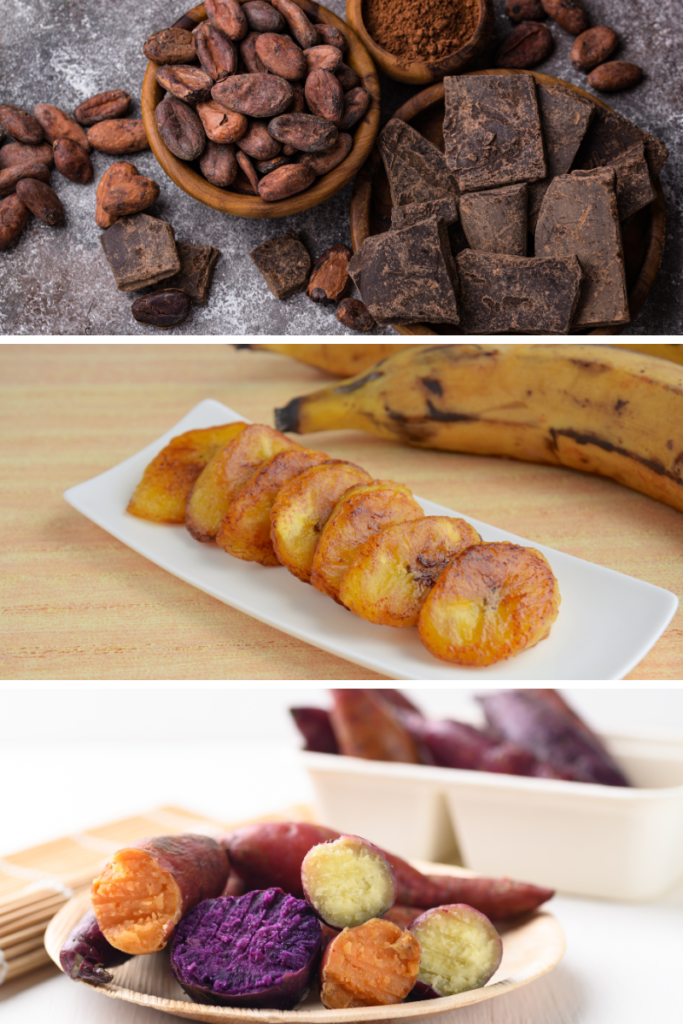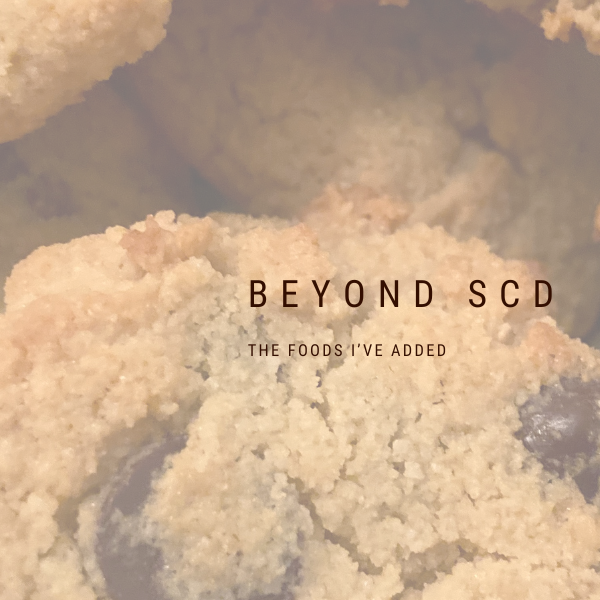Transitioning from a strict Specific Carbohydrate Diet (SCD) has been both a rewarding and enlightening journey. I’ve carefully reintroduced several foods into my diet to enhance variety, satisfaction, and overall health. Each addition has brought its own unique set of benefits and considerations, especially for those of us managing Inflammatory Bowel Disease (IBD) in remission or with low symptoms. Here’s a look at some of these foods, their health benefits, and the reasons why they might not work for everyone.
My Top Beyond SCD Foods

1. Unsweetened Cocoa
Pros:
- Antioxidants: Unsweetened cocoa is rich in flavonoids, which have powerful anti-inflammatory and antioxidant properties. These can benefit gut health by reducing oxidative stress and inflammation .
- Mood Booster: Cocoa contains compounds like phenylethylamine and serotonin precursors, which can enhance mood and reduce stress. This can indirectly benefit IBD management, as stress is often a trigger for symptoms .
Cons:
- Fiber Content: High fiber content can be problematic during a flare-up, potentially irritating the digestive tract .
- Caffeine and Theobromine: These stimulants may cause digestive discomfort in some people, leading to symptoms like diarrhea or abdominal pain .
How I use it:
- I like to add to add the unsweetened cocoa powder to smoothies and baked goods. I like to use solid unsweetened cocoa for chocolate chip cookies and homemade candy.
2. Plantain
Pros:
- Nutrient-Dense: Plantains are packed with vitamins A and C, and potassium, which support overall health and can help in maintaining a balanced diet .
- Resistant Starch: Acts as a prebiotic, feeding beneficial gut bacteria and promoting a healthy microbiome .
Cons:
- Fiber Content: The high fiber content can be difficult to digest during active disease phases, potentially causing discomfort .
- Preparation: Proper cooking is essential to make plantains easily digestible and to avoid potential digestive issues.
How I use it:
- Plantains are so versatile! I do eat them green and they are great for using in place of bread for sandwiches. I also like to make tostones, chips, and use them for croutons in a salad or in place of potatoes for a hash. Plantains are great baked, mashed, or fried for a side dish. I have made tortillas and a tamale casserole topping with them. They are my favorite beyond SCD addition.
3. Sweet Potato
Pros:
- Anti-inflammatory: Sweet potatoes are rich in beta-carotene and other antioxidants, which help reduce inflammation, a critical factor for those managing IBD .
- Easily Digestible: When cooked thoroughly, sweet potatoes are generally gentle on the digestive system and easy to tolerate .
Cons:
- Moderate Fiber: The fiber content, although beneficial in moderation, might be challenging for some during flare-ups .
- Sugar Content: The natural sugars in sweet potatoes can affect individuals with sensitive digestive systems, potentially leading to discomfort .
How I use it:
- I typically cube them and fry them for a breakfast potato substitute. I also love to make sweet potato fries, especialy with the white sweet potatoes. The traditional orage and great basked or mashed. The puprple sweet potatoes are delicious baked, mashed, or fried. Many people use the purple sweet potatoes to make all kinds of pruple desserts and side dishes.
4. Quinoa
Pros:
- Complete Protein: Quinoa is one of the few plant-based foods that contain all nine essential amino acids, making it an excellent protein source .
- Low Glycemic Index: Helps maintain stable blood sugar levels, which is beneficial for overall health and energy levels .
Cons:
- Fiber Content: The high fiber content might not be well-tolerated by everyone, particularly those with active symptoms .
- Saponins: Quinoa needs to be thoroughly washed to remove saponins, which can irritate the gut and cause digestive discomfort .
How I use it:
- Typically I cook quinoa plain and use it as a side dish or mix meat and vegetables with it. I also occasionally use puffed quinoa as a cereal or as an ingredient in homemade snack bars. I have also tried quinoa flakes as a hot cereal, but I don’t care for the taste of it.
5. Cassava Root
Pros:
- Gluten-Free: Cassava is naturally gluten-free, making it a safe choice for those with gluten intolerance or celiac disease .
- Calm Carbohydrate: When cooked properly, cassava is low in FODMAPs, making it easier to digest and less likely to cause digestive upset .
Cons:
- Cyanogenic Glycosides: Cassava contains these compounds, which can be toxic if not properly prepared. Proper cooking is essential .
- Low Protein: It lacks significant protein content, so it should be consumed as part of a balanced diet .
How I use it:
- I have cassava very infrequently. It works well in grain-free tortilla chips and taco shells. Cassaca chips can also be bought on their own.
6. Flax Seed
Pros:
- Omega-3 Fatty Acids: Flax seeds are a great source of omega-3s, which have anti-inflammatory properties beneficial for managing IBD .
- Soluble Fiber: Can aid in bowel regularity and improve overall gut health .
Cons:
- High Fiber: The high fiber content might be too harsh on the digestive system during flare-ups, leading to potential discomfort .
- Phytates: Flax seeds contain antinutrients that can interfere with mineral absorption, which might be a concern for some individuals .
How I use it:
- Ground flax is recent additon for me. I have made flax crackers with it. It’s very easy to stir it into baked goods recipes or even as a filler in meatloaf.
7. Arrowroot Powder
Pros:
- Easily Digestible: Often used as a thickener, arrowroot powder is gentle on the stomach and easy to digest .
- Low-Allergen: Generally hypoallergenic, making it a safe choice for those with multiple food sensitivities .
Cons:
- Low Nutrient Density: Primarily a starch, arrowroot lacks significant vitamins and minerals, so it shouldn’t be a primary nutrient source .
- High Glycemic Index: It can spike blood sugar levels, which may not be ideal for everyone, particularly those with blood sugar management issues .
How I use it:
- I use arrowroot very infrequently, but it does work well as a thickener and as binder in baked goods.
8. Bifidobacterium

Pros:
- Probiotic Benefits: Helps maintain a healthy balance of gut bacteria, which is crucial for managing IBD symptoms and overall gut health .
- Anti-inflammatory: Can reduce gut inflammation and improve intestinal barrier function, which is essential for those with IBD .
- Symptom Relief: May help reduce bloating, gas, and other digestive discomforts associated with IBD .
Cons:
- Individual Variation: The effectiveness of bifidobacterium can vary significantly from person to person, so it may not work for everyone .
- Dietary Sources: Often requires supplementation or consumption of fortified foods, as bifidobacterium is not abundant in regular diets .
How I use it:
- Bifidus is not really something I added in, but something I pretty much always had. My version of Breaking the Vicious Cycle (1999 edition), didn’t exclude Bifidus and I didn’t know it was something that had been removed from SCD until hearly 15 years after I started. I did exclude it for a brief period because I thought I was supposed to, but as I did more reseach on it, and started to feel a little off, I added it back. The yogurt starter I use contains bifidus and that is my primary use, though I have on occasion used a probiotic supplement that contained it.
Incorporating these foods and bifidobacterium into my diet has provided me with variety and numerous health benefits. However, it’s essential to recognize that individual responses can vary significantly. Consulting with a healthcare provider or dietitian is crucial for personalized dietary management.
I will be sharing more of my “beyond SCD” journey. Be sure to stay tuned!
- No-Bake Peanut Butter Bars (SCD, GAPS, Gluten-Free) - May 27, 2025
- Stuffed Spaghetti Squash with Chicken, Heirloom Tomatoes & Kale - May 23, 2025
- Grain-Free Hummingbird Cake (SCD-Friendly + So Good) - April 17, 2025



Follow Happy Gut For Life